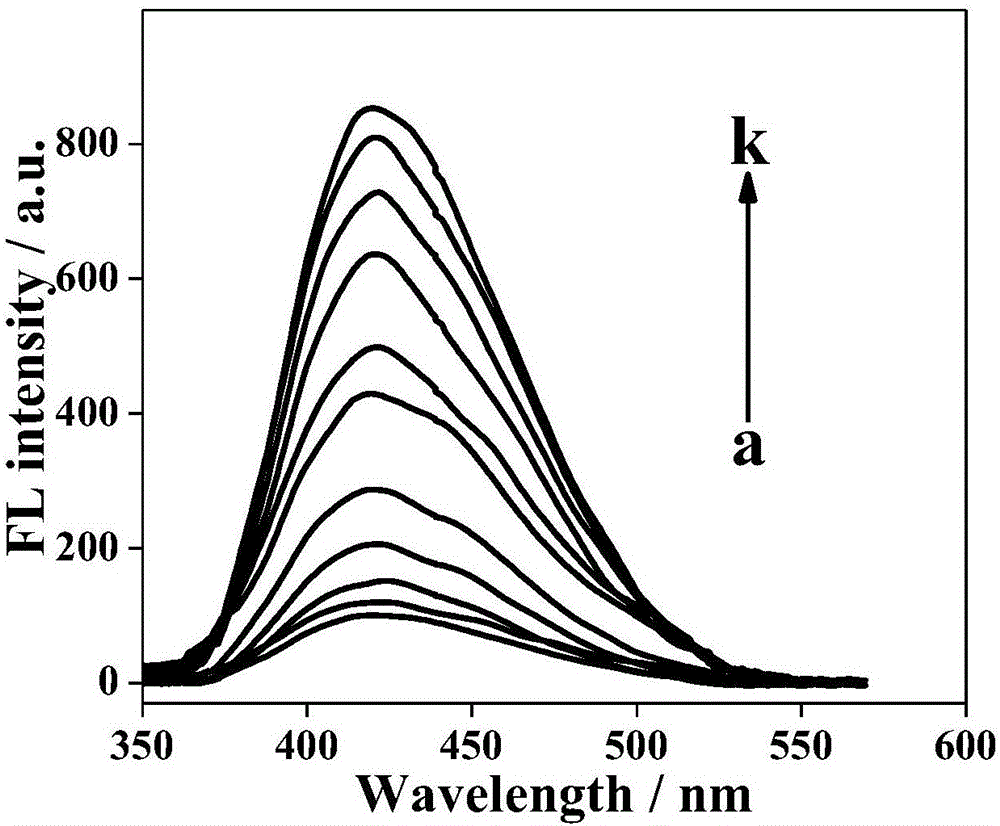Method for constructing fluorescence resonance energy transfer sensor and method for detecting CaMV35S promoter by means of sensor
A fluorescence resonance energy and detection method technology, applied in fluorescence/phosphorescence, instruments, measuring devices, etc., can solve the problems of complex detection scheme, long detection time, high detection cost, etc., and achieve clear design ideas, fast analysis speed, and easy operation flexible effects
- Summary
- Abstract
- Description
- Claims
- Application Information
AI Technical Summary
Problems solved by technology
Method used
Image
Examples
Embodiment 1
[0034] (1) Preparation of MWCNTs / GONRs
[0035] MWCNTs / GONRs were obtained by oxidative shearing of multi-walled carbon nanotubes. The specific process was as follows: 120 mg of multi-walled carbon nanotubes were weighed into a round bottom flask, and 40 mL of H 2 SO 4 / H 3 PO 4 (volume ratio is 9:1) and stir, then add 600mg KMnO in the above mixed solution 4 , and continued to stir for 2 h in an oil bath at 65°C. After the reaction, the solution was cooled to room temperature, and it was poured into 400 mL containing 0.375% H 2 o 2 In ice water, the solution was filtered through a PTFE membrane (pore size 0.2 μm) to obtain solid product MWCNTs / GONRs, and washed several times with water, and finally dispersed in deionized water to obtain a MWCNTs / GONRs dispersion with a concentration of 1.5 mg / mL.
[0036] (2) Preparation of NSGQDs
[0037] Nitrogen and sulfur heterographene quantum dots (NSGQDs) were prepared in one step by thermal cracking under normal pressure. After...
Embodiment 2
[0042] Embodiment 2: The construction of the FRET sensor to tDNA standard curve
[0043] Add 4 μL of 1.5 mg / mL MWCNTs / GONRs dispersion to 3.0 mL of NSGQDs-ssDNA, sonicate for 5 min, and after standing for 5 min, measure the fluorescence intensity of the MWCNTs / GONRs-NSGQDs-ssDNA system, then add 15 μL of tDNA of different concentrations, After ultrasonication for 5 minutes, stand still for 40 minutes to measure the degree of fluorescence recovery and construct a standard curve.
[0044] figure 1 It is a standard curve diagram for detecting different concentrations of CaMV35S target DNA, wherein the curves a to k are in the order from bottom to top, and the concentrations of the target DNA are 0, 0.1, 0.5, 1, 5, 10, 50, 100, 200, 400, 500 nM. Curve a indicates that when no target DNA is present, NSGQDs are adsorbed to the surface of MWCNTs / GONRs, resulting in fluorescence quenching, thus showing lower fluorescence intensity. When the target DNA was added, hybridization and co...
Embodiment 3
[0046] FRET sensor based on MWCNTs / GONRs-NSGQDs-ssDNA for detection of transgenic soybean:
[0047] The DNA of transgenic soybeans was extracted using a plant DNA extraction kit. Add 4 μL of 1.5 mg / mL MWCNTs / GONRs dispersion to 3.0 mL NSGQDs-ssDNA, sonicate for 5 min, and after standing for 5 min, add 20 μL of transgenic soybean DNA into MWCNTs / GONRs and NSGQDs-ssDNA FRET sensing system, Determine the fluorescence recovery intensity and compare it with the standard curve to draw a conclusion whether the CaMV35S promoter is contained, and the concentration of the CaMV35S promoter contained in the transgenic soybean can be calculated according to the fluorescence intensity.
PUM
 Login to View More
Login to View More Abstract
Description
Claims
Application Information
 Login to View More
Login to View More - R&D
- Intellectual Property
- Life Sciences
- Materials
- Tech Scout
- Unparalleled Data Quality
- Higher Quality Content
- 60% Fewer Hallucinations
Browse by: Latest US Patents, China's latest patents, Technical Efficacy Thesaurus, Application Domain, Technology Topic, Popular Technical Reports.
© 2025 PatSnap. All rights reserved.Legal|Privacy policy|Modern Slavery Act Transparency Statement|Sitemap|About US| Contact US: help@patsnap.com

